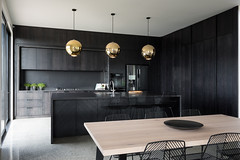
More Detail Here:
By Ralph Winn
You have a safe to store your valuables, so why not have a safe to store your most precious possession of all: your life?
Escape to a Panic Room
A panic room, a room in your house that is outfitted with reinforced walls and insulation and features sturdy metal doors that lock tight, acts as a vault for people. Inside, you can keep comfort and survival items like cots, canned goods, water, a cell phone, and a radio.
Keeping Safe
Arizona couple Ed and Patti Warner feel safe in their 3 million dollar, 10,000 square foot secluded home because they have a 4 foot by 6 foot fireproof panic room tucked under their staircase. ‘If you go in there and shut the door, nobody can get to you – nobody. You could take your cell phone and call the police – it would be safer than running outside,” says Patti.
Think it sounds a little paranoid? Not to the millions of American families who are building additions or retrofitting their homes to include a panic room. The price of safety and peace of mind can range from around $3,000 to over $1 million. But no matter the price, the purpose of the panic room is the same: to protect you in an emergency.
The idea of a panic room became more popular nationwide after the terror of 9/11 and the release of the Jodie Foster movie Panic Room, in which Foster and her character’s daughter are sequestered in their home’s panic room when their house is invaded. The idea of a safe haven in the home took off with worried Americans who feel more and more threatened in this modern society.
‘Business spiked a little way up after Sept. 11, and it’s mellowing out a little now, but this is an industry where demand goes up every year,’ says Bill Rigdon, vice president of construction for Los Angeles’ Building Consensus, which designs and builds panic rooms for wealthy clients ranging from movie stars to CEOs. ‘Since 1995, there’s really been an uprising for these rooms – people don’t even feel safe in their own homes.”
When Do You Use a Panic Room?
There are multiple scenarios in which a panic room can save lives.
Home Invasion: If intruders invade your home, you can immediately retreat to the panic room and remain out of harm’s way until the police arrive.
Hurricane: A panic room’s reinforced walls make it the room in your house most likely to survive a major storm. As long as your home is not threatened by the deadly storm surge, you can ride out a hurricane in your panic room until it clears.
Tornado: Hurricanes are predictable and you have plenty of time to prepare, but tornados put the ‘panic’ in the term ‘panic room.’ In the event of a tornado, you may have only seconds to seek shelter, and an easily accessible panic room at the center of your home could literally save your life. You can stay safe there until danger passes. The rest of your house may crumble, but a panic room is designed specifically to withstand disaster.
Yesterday’s Fallout Shelters
Today’s panic rooms are yesterday’s fallout shelters. Both reflect the fears of their time: nuclear war and modern terrorism in all its forms. But today’s panic rooms are a little more high tech than their cousins of yesteryear.
Available Features of a Panic Room
—
Dummy electrical wires (So the intruder thinks he’s cutting the power, but he’s not.)
—
Steel-reinforced walls that deflect armor-piercing bullets.
—
External ventilation systems.
—
A separate phone line.
—
Bathroom facilities.
—
Security cameras.
—
Shielding from nuclear rays.
A panic room can be anything you dream it to be. It can be as complex as a multi-room bunker or something as simple as an extra-sturdy walk-in closet stocked with a few days’ survival supplies. All panic rooms offer the same basic benefit: safety and peace of mind in an emergency situation. Everyone wants to know they have a place where they can be safe. Do you?
‘People are transformed when they go into one of these rooms or areas,’ says Al V. Corbi, president of The Designer, which designs high-end residences. ‘It’s like you can see them exhale for the first time in years. We’re always on our guard, even driving to work. A safe core is the only place where you can really let down your guard.’
About the Author: Ralph Winn writes about
Home Security
and other related topics. For more information on
Home Security
Source:
isnare.com
Permanent Link:
isnare.com/?aid=155744&ca=Home+Management